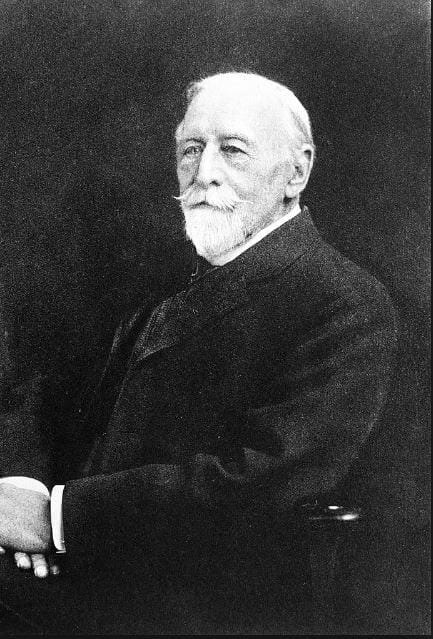
Sir Thomas Clifford Allbutt (1836-1925) was an immensely influential British physician who spanned the transition from Victorian to modern medicine, a Renaissance man who helped advance our understanding of disease in many different areas. He is especially remembered for his work on hypertension and cardiac disease, writing as he was at a time when it was just becoming possible to measure blood pressure in the clinic. This also coincided with a growing understanding that enlargement of the heart and sclerosis of blood vessels could occur even in the absence of kidney disease. This was in contradiction to the prevailing view that kidney disease came first (in the form of so-called Bright’s disease) and caused cardiac hypertrophy and vascular sclerosis by altering the composition of the blood (producing “uremic poisons”). By 1880 investigators at Guys Hospital had already published reports of patients with hypertension and no signs of kidney disease (“Bright’s disease without albuminuria”).1,2 But it was Clifford Allbutt who helped popularize this concept by reporting in 1896 a series of clinical cases with elevated blood pressure but no evidence of kidney disease. This he defined as “a disease which independent of the kidneys has its own characters, of which high arterial blood pressures, systolic and diastolic, seem to be the chief.”3 He called this disease hyperpiesia, a term that continued to be used, at least in England, until well into the 1930s. But other physicians advocated different names, such a presclerosis and hypertonia, and eventually the term hypertension prevailed, generally qualified by “essential” when it cause was not known.4,5
In his 1915 textbook Allbutt also mentioned that it was still difficult to obtain accurate blood pressure readings in many patients; recognized that stress and anxiety could elevate blood pressure (white coat hypertension), alluded to the role of excessive salt intake, and suggested that “heavy feeders” and gluttons were more likely to develop high blood pressure. He also extended his research to the study of angina pectoris, which he however insisted to be primarily due to an increase in the tension of the nerves of the root of the aorta rather than to coronary disease, as postulated by Sir James Mackenzie and clearly shown by James Herrick in 1912 in Chicago.6
Clifford Allbutt was described by his contemporaries as courtly and aristocratic in demeanor, gracious of mind and bearing, serious, but somewhat humorless. Born in Leeds and educated at Cambridge, he practiced medicine in Leeds for 28 years and was on the staff of the General Infirmary there. He was highly respected and lectured for many years on anatomy and medicine. In 1866 he invented a portable six-inch clinical thermometer that could allow one to measure a patient’s temperature in five minutes, replacing the twelve-inch standard model that required 20 minutes.6-9 In 1871 he published a paper advocating the use of the ophthalmoscope in clinical practice, and took advantage of this new instrument to describe important physical signs in various diseases, mainly neurological.6-9 His name has also been linked to the description of neuromyelitis optica, a combination of optic neuritis and myelitis. He also made contributions to the understanding of infectious disease, studying at various times syphilis, scrofula, rabies, and, during the 1918 pandemic, influenza.
After retiring from clinical practice, Clifford Allbutt served briefly as Commissioner for Lunacy in England and Wales, and in 1892 was appointed to the prestigious position of Regius Professor of Physic at Cambridge. There he edited a vast “system of medicine,” for many years the standard reference medical textbook, expanded from eight volumes (1896–1899) to a second edition of eleven volumes (1905–1911).6-9 He was a student of the classics, wrote several learned works on medicine in ancient times, Greek and Roman and also Medieval, including an extremely detailed article on the history of medicine in the 1911 edition of the Encyclopedia Britannica. He believed that “we need science in our classics as we need humanity in our science,” and he was distressed by the poor writing skills and the slovenly, ungrammatical English of the average medical student, who did not even write as well as the “gentlemen” who reported on fires and murders in local newspapers.6 He was friends with George Eliot, who visited him in Leeds and was struck by his wide culture and charm. It has been suggested, but also denied, that she used him as a prototype for least some of the characteristics of the main hero Lydgate in her novel Middlemarch. He was elected Fellow of the Royal Society, knighted, received no fewer than nine honorary degrees, served on many government bodies, and was particularly interested in medical education and in bedside medicine, urging his student to spend time with their patients on the wards rather than study their textbooks at home. He became known as “the Grant [sic] Old man of British Medicine,”8 a man of immense influence, and remains to this day an important figure in the history of medicine.6-9
References
- Cameron JS. The description of essential hypertension by Frederick Akhbar Mahomed. Nephrol Dial Transpl. 1995; 10:1244.
- Cameron JS and Hicks J. Frederick Akhbar Mahomed and his roe in the descriptionof hypertension at Guy’ sHospital. Kidney International 1996;49:1488.
- Allbutt TC. Senile plethora or high blood pressure in elderly persons. Trans Hunterian Society, 1896;96:38.
- Huchard H. Maladies du coeur et des vaisseaux. Paris:Doin, 1889.
- Frank E. Essentielle Hypertonie. Deutch Arch Klin Med 1911; 103:397.
- Alexander G Bearn. Sir Clifford Allbutt. Scholar and Physician. History and Heritage Series. http://books.google.com
- Pierce, JMS. Neurol Neurosurg Psychiatry, 2003;74:1443
- The Times, Feb 23, 1925; pg. 19. — Sir C. Allbutt, Service to English Medicine.
- Lives of the fellows. Munk’s Roll:volume IV – Sir Thomas Clifford Allbutt. http://munksroll.rcplondon.ac.uk

Leave a Reply